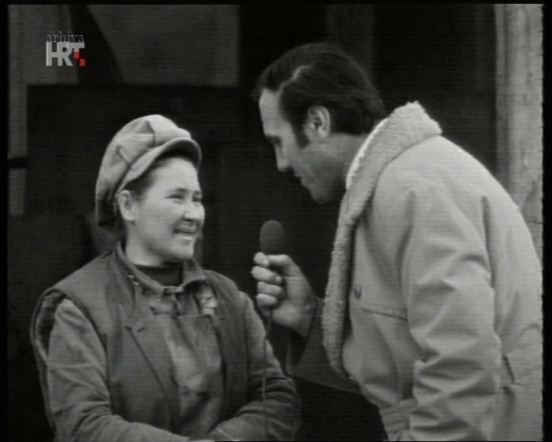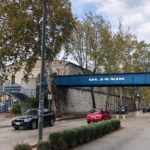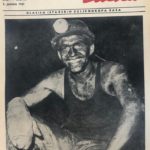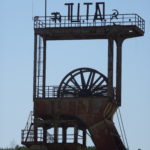In the history of Pula – a town whose modern development is strictly tied to a military and industrial presence – the dates of 15 January and 2 May 1972 are particularly important. Although never celebrated on a local or republic level, on those days, a Saturday and Tuesday respectively, the largest and most complex vessel ever built in an Adriatic shipyard was christened by breaking a bottle of champagne on the stern, and being dragged out of Pula’s harbor. Berge Istra was a ship designed, produced and fitted in Pula’s shipyard Uljanik and it marked a turning point in the shipyard’s politics of production. Its production was, on the other hand, such a significant event that it provoked the development of several feature and documentary films: Kolos s Jadrana (Adriatic Colossus), whose scenario was written by Branko Knezoci, and directed by Darko Vizek (RTV Zagreb, 1972) and Berge Istra directed by Frano Vodopivec, based on the scenario written by Josip Iskra (Jadran film, 1972) and released in a Croatian and English version. These movies are not the first documentaries with an Uljanik shipbuilding theme: in his Istarski puti (1952), Branko Belan touched on the theme of Uljanik after the war reconstruction and production plans and in 1968 the feature movie Jadranbrod explained the process of ship designing. Kolos s Jadrana and Berge Istra are a particular kind of documentary. They are entirely focused on illustrating the success of the work collective, a historically important production zenith – the construction of the ship Berge Istra. This success seems even bigger knowing that just a few years before this feat and after the introduction of the 1965 economic reforms, the lower incomes resulted in a great dissatisfaction:
It escalated with the strike in September 1967 […] the discipline turned out to be the real problem and the normal functioning of shipyard was not possible […] considering the fact that Uljanik had fulfilled production capacities up until 1970. It had contracted ships and signed contracts for the construction of three ships for India worth $27 million and three vessels for Norway valued at $16.8 million.
Stanić 2016: 75, 90
Therefore, we should partially interpret these documentaries as demonstrating how the economic problems that tormented Uljanik, as well as the Croatian and the Yugoslav economy in those years, were overcome. Bearing that fact in mind, I will, however, in this paper focus primarily on the politics of representation in the abovementioned movies within the context of the historical anthropology of documentary film, and focus less on the economic oscillations of those years. I am interested in the representation and narration of shipbuilding, the aspects of christening and ship launching that are not shown in the movies, yet constitute the everyday aspect of this important event: problems that occurred during the construction and launching and the wider social and symbolic connections between Norway and Yugoslavia on the occasion of the ship’s christening, and the gender aspect to such work.
A gigantic ship
If we were to seek a common denominator between the parts of the film and newspaper opus that presented the completion and christening of the ship Berge Istra to a wider audience, it could be captured by the term gigantophilia. This is because this ship – and the admiration it provoked – was not just big, it was walloping. The title Adriatic Colossus reminds us of that, as does the plethora of adjectives and phrases used to describe it: “giant,” “mammoth,” “super-mammoth,” “colossus,” “floating island,” “a giant of our shipbuilding” (orijaš naše brodogradnje) (Iskra 1972b), compared with which the other ships were – the movie reminds us – “real dwarfs.” When shipped from the harbor, it left an “emptiness in Pula’s panorama, it was as if the Arena [Pula’s colosseum] was missing because these objects can be compared in size” (Iskra 1972a). Built in fourteen months for the Norwegian shipowner Sigval Bergesen and the company D.Y. and Co., Berge Istra had, as underlined in Adriatic Colossus:
225 thousand tons of deadweight, it is the biggest bulk carrier currently built in the world, the largest ship ever constructed in Adriatic shipyards. The biggest ship built until now – a tanker of 88 thousand tons built in Split is three times smaller. The maximum load is such that it will be able to carry at once the same weight as 22,500 wagons; i.e. its insides will be able to contain 440 train compositions with 50 wagons each. Due to its size, the ship is as long as three soccer pitches, Berge Istra will not navigate on the usual routes nor will it be able to sail into many European harbors, fully loaded it will wade twenty meters. Unloaded, this giant is as tall as a skyscraper of ten floors.
With a length of 314 meters, a width of 50 and a height of 26 meters, joined together from two parts – a stern and bow – Berge Istra was welded in the sea, a highly innovative technical procedure for that time, practiced only in a small number of shipyards. Berge Istra, above all, marked out Uljanik’s orientation for building bigger ships – so-called mammoths – among which the other three were delivered to the same purchaser, Sigval Bergesen: Berge Adria, Berge Brioni and Berge Vanga (Markulinčić & Debeljuh 2006).

Berge Istra, 1972 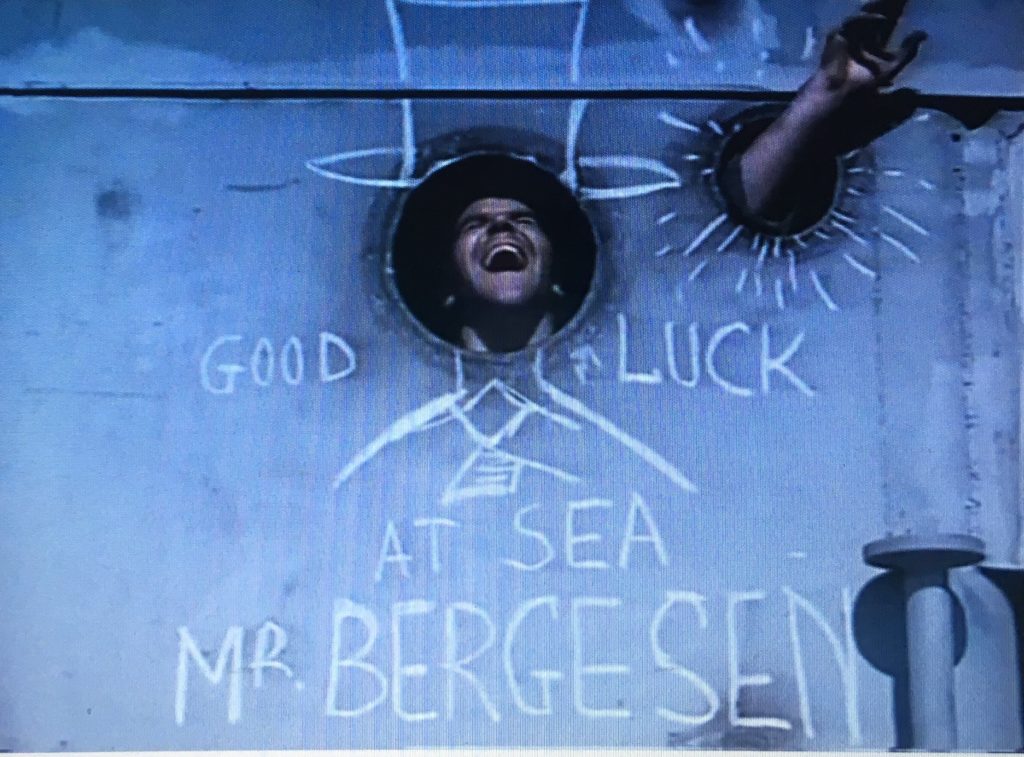
Good Luck at Sea Mr. Bergesen, Berge Istra 1972
The event
In addition to the impressive numbers put forward in Adriatic Colossus and Berge Istra, the ship’s christening on 15 January1972 was also a political, social and economic happening. Besides Jovanka Broz, the godmother of the ship, and Uljanik’s general director Albert Foskio, the President of the SFR Yugoslavia Josip Broz Tito, member of the presidency of the League of Communists of Yugoslavia Vladimir Bakarić, president of the Socialist Republic of Croatia’s Parliament Jakov Blažević, president of the executive council of parliament Ivo Perišin, secretary of the Executive committee of the League of Communists of Croatia Josip Vrhovec, vice admiral Ivo Purišić as well as the ambassador of the Kingdom of Norway Johan Cappelen, Mr. and Mrs. Bergesen also attended the launch. All of them listened to the speech given by the ship’s godmother. However, before her speech, it is interesting that the authors of the Adriatic Colossus filmed inside the worksites and workshop halls in “order to meet this big Istrian work collective.” They spoke there with “comrade Crnobori, one of the builders of this ship, comrade Šegota, the head of assembly on Berge Istra and with an unnamed woman welder who has been ‘doing this as her job for 17 years now.’” This is, as far as I know, the first interview with a woman welder completed in Yugoslavia.
Amidst the reams of technical information given by the engineers and forepersons, initial concerns dominate those interviews, as well as the difficulties, not small in number, that they experienced during this brand new project:
This ship was born after many, many problems and questions by several people; there was a lot of skepticism, particularly in earlier times. We have to admit that Uljanik before its orientation toward mammoth ships did not have any experience, nor theoretical knowledge that could be used; we were in a difficult situation when we had to calculate the weight of the steel we had to use. On these big ships, the weight of steel is the most important […] that was the riskiest part when defining its deadweight.
The initial skepticism and disorientation made the construction of Berge Istra an even bigger success. However, when analyzing the Adriatic Colossus, what it does not show to the viewers is also important. This documentary does not show, nor does it reproduce openly, the performed enthusiasm or concrete problematic situations that occurred during the production of the ship. A narrative structure that included the representation of highly problematic situations in industrial production is characteristic of the post-war documentaries, e.g. Borci za višu produktivnost rada (Branko Bauer), Još jedan brod je zaplovio. Spašavanje broda “Ramb” (Krešo Golik), 100 dana u Brezi (Zoran Markuš) or Događaj u Raši (Rudolf Sremec) (cf. Matošević 2015: 109–17). The representation of labor or workers in Colossus, as well as in Berge Istra, does not let us see any of the problems that occurred during production, yet during the seventies the workers were involved in highly risky situations. As a former shipbuilder told me:
People did not use protective gear! But there was a problem with asbestos, and there are several other, but this was a professional disease. But, this was difficult, to make him protect himself, you just couldn’t. And they had simple gasmasks. But they couldn’t make it, just couldn’t, and now you can see all those deaths, how many of them died being sick, they had bad lungs, asbestosis. And it was done all the time, they wouldn’t let go – “put on the mask, do that,” but the bosses were not always around to look over them, and it was – “yes, yes we will,” they knew it was bad but kept on working. Keep the mask while the boss is here and later when he left, throw the mask aside. We worked, yes.
E. L., interview
“floating island,” it also partially covers it up. Thus, we should notice that Adriatic Colossus lets us see the very finalization of the production process – the christening and the minor final works during which all the workers wear protective gear and the work runs smoothly, to be interrupted only by the film crew in order to talk “quickly with workers, in between significant moments in the shipyard.” In both movies, particularly Berge Istra, where the launching of the stern and bow is a major theme, there are no mentions of difficulties that occurred during the process. However, at the end of February 1971 during the launching of the bow, this is what happened:
Around 9 a.m., a great number of people gathered around “Uljanik,” expecting with great impatience the launching of the bow part of the biggest ship ever built in our country. Although the weather was surprisingly cold the viewers kept on approaching the fence and the space around the marine church. But the big ship surprised them. True, it started moving from the spot and kept on moving for three more days without accelerating. The jokers almost immediately noticed that the sea was cold and the ship was not willing to sail […] This was a struggle for millimeters. After all the routine preparations had been made and the last obstacle – the cable stoppers – had been removed, the ship started to slide one millimeter per minute. As the expected acceleration never started, it was a clear sign that something was not right. There was no panic, but the preparations for additional pushing with hydraulic pushers were immediately made. When the first push with 200 tons failed, stronger ones with 800 and 1000 tons started. But those were also unsuccessful. On Sunday evening it was clear that the ship had to be stopped and that new preparations for a launch had to be made. But the workers on the berths and all other staff were willing to try further attempts, and they were made. The struggle continued […] The temperature kept on descending. The water that spurted from the hydraulic pushers immediately turned into ice. People watched all that and went to warm up. Many tough men cried. And when it was clear that all was in vain, the ship had to be stopped and new preparations had to be made for a launch, which would happen in a month’s time.
Although in both documentaries, the authors use narrative segments not of an exclusively technical and shipbuilding nature, e.g. in Berge Istra the narrator cites the Bible and in Colossus the connection between the city of Pula and Uljanik is mentioned in a few sentences, these movies should be nevertheless positioned near the technical movie genre. This does not mean that we are not dealing with “highly complex movies,” whose filmed sequences and narration are “chosen and published in order to show a particular point of view” (Burke 2007: 28), with the workers’ representation resulting in their particular image. This insisting on an image that does not contain any mention of problems, difficulties, improvisation or misfortunes that occurred during the construction process makes these movies narratively similar to newsreels filmed in Raša, Istria during the late 1930s. In those short movies on miners, only successes were filmed – building new houses and displaying new techniques at the facilities and worksites. Such ideal representation “provided ammunition that could claim all sides to be winners,” but the “photographers might be kept away or find their access limited in the case of a mining accident” (Wells Greene 2005: 69, 66). As applied to our shipyard example, this means that insisting on technical information, numbers and rather formal interviews – with the only exception being the more intimate dialogue with a woman welder at her workplace, describing her satisfaction, paycheck and family – primarily portrays the ship as an object, while the process of achieving success, during which improvisations and even serious problems occur, are not stressed as relevant. In order to gain that information we have to consult other sources. In other words, although one of the shipbuilders will claim in Adriatic Colossus that the ship was constructed by “adapting old berths, constructing new cranes,” the object in the final representation pushed out the process: the gigantic ship shadowed the creative part of its own construction. Such an ideal representation is much closer to managers’ and engineers’ viewpoints in plants than to the worker’s point of view. This is, then, a specific and not a “natural” epistemology and interpretation of work and the work process (cf. Matošević 2011: 275).
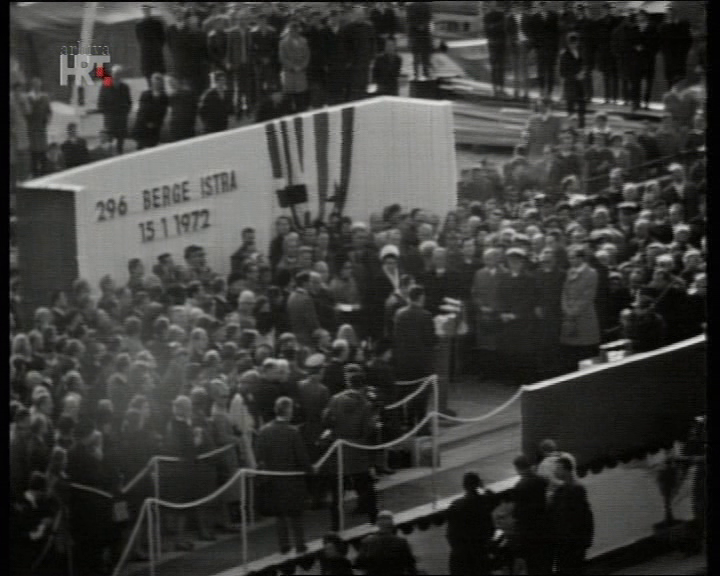
Adriatic Colossus (Kolos s Jadrana), 1972 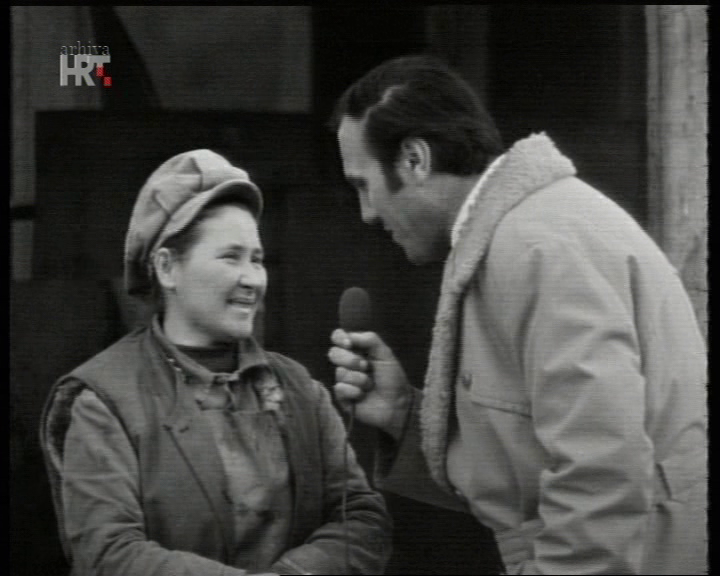
A woman welder, Adriatic Colossus (Kolos s Jadrana), 1972
Friendship connections
The launching of the ship was not only political but also a strong and multilayered social happening. Sigval Bergesen, Berge Istra’s owner, on the occasion of visiting Pula stated:
In the House of the Army at 10: 30 I will hand a present to the city of Pula and Uljanik workers: modern ambulance car keys that will help save injured people in traffic and a stereo loudspeaker for the Uljanik shipyard. Mr. Bergesen said, when he chose a gift for the Uljanik collective, that he wanted it to be in the service of fun for all the workers of this collective whose work he appreciates, particularly since he saw the work they were doing for him. When speaking about the ambulance he said that he wanted a city to have one state-of-the-art car, but that at the same time he wishes that it gets used as rarely as possible.
Iskra 1972c
In reply to his present, the president of the community assembly, “Josip Lazarić gave Mr. Bergesen the highest recognition of the commune – a golden medal, and Mrs. Bergesen an original amphora dated from the III. century A.D.” This symbolic exchange – that resulted from building the ship Berge Istra, turned out to be “a connection of friendship between people” (Iskra 1972b). It was followed by a meeting between Tito, his wife Jovanka and Mrs. Kirsten Svineng – Mamma Karasjok, who met in Medulin, in the Belvedere hotel. This nickname was given to Mrs. Karasjok by Yugoslav “internees in Norway during World War II when she helped them. Mamma Karasjok is now 80 years old, and her nickname is a reminder of the place in northern Norway where she lives” (Brodograditelj 1972a). It is quite clear that the christening of the Berge Istra ship in the Uljanik shipyard was an event composed of several aspects, but the documentaries that were filmed concentrated exclusively on showing the production process without mentioning any difficulties the collective had to pass in order to finish this task. The process shown in the Berge Istra movie was dominated by a connection of the stern and bow that “was simultaneously welded by 45 welders, at a distance of 1.5 meters.” The documentaries do not mention the wider significance of this event, which included “friendship connections” – an exchange of gifts between the Norwegian shipowner and representatives of Pula, but also including individuals like Kirsten Svineng who helped more than several internees to survive during the World War II. Mama Karasjok opens up the interesting theme of a symbolic interconnection between the economy and World War II, which can be traced back from 1945 onwards. It can therefore be justifiably claimed that these movies filmed during the 1970s showcase a variety of visual and sound “industrial postcards,” strengthened by impressive photography and camera sequences – including close-ups of berths, worksites and launches
Andrea Matošević is Associate Professor at the Juraj Dobrila University of Pula with interests in ethno-anthropology, history of ethnology/anthropology, oral history, industrial anthropology, popular culture, theories of multiculturalism and philosophy.
BIBLIOGRAPHY
Brodograditelj.1972a. “Trenutak s Mamom Karasjok.” 27 January, 5.
Burke, Peter. 2007. Testimoni oculari. Il significato storico delle immagini. Roma: Carocci editore.
Iskra, Josip. 1972a. “Berge ide…”. Brodograditelj. 1 January, 9.
Iskra, Josip. 1972b. “Dajem ti brode ime.” Brodograditelj. 27 January, 3.
Iskra, Josip. 1972c. “Bergesenov poklon Puli i ‘Uljaniku’“. Brodograditelj. 27 January, 10.
Markulinčić, Hrvoje & Armando Debeljuh, eds. 2006. Uljanik 1856-2006. Pula: Uljanik d.d.
Matošević, Andrea. 2011. Pod zemljom. Antropologija rudarenja na Labinštini u XX. stoljeću. Zagreb, Pula: Institut za etnologiju i folkloristiku, Sveučilište Jurja Dobrile u Puli.
Matošević, Andrea. 2015. Socijalizam s udarničkim licem. Etnografija radnog pregalaštva. Zagreb, Pula: Institut za etnologiju i folkloristiku, Sveučilište Jurja Dobrile u Puli.
Stanić, Igor. 2016. “‘Jedan od najtežih dana u Uljaniku!’ Štrajk u Brodogradilištu Uljanik 1967. godine.” Problemi sjevernog Jadrana 15: 73–95.
Vjesnik Uljanika. 1977. “Kad veliki brod nije htio u more.” 27 December, 13.
Wells Greene, Janet 2005. “Cameras in the Coalfields. Photographs as Evidence for Comparative Coalfield History.” In Towards a Comparative History of Coalfield Societies. Stefan Berger, Andy Croll & Norman LaPorte, eds. Aldershot: Ashgate, 65–86.
Filmography
Berge Istra. 1972. Scenario Josip Iskra, dir. Frano Vodopivec. Jadran film.
Kolos s Jadrana. 1972. Scenario Branko Knezoci, dir. Darko Vizek. RTV Zagreb.
Interview
E. L., crane-operator, interview conducted 9 July 2012.
